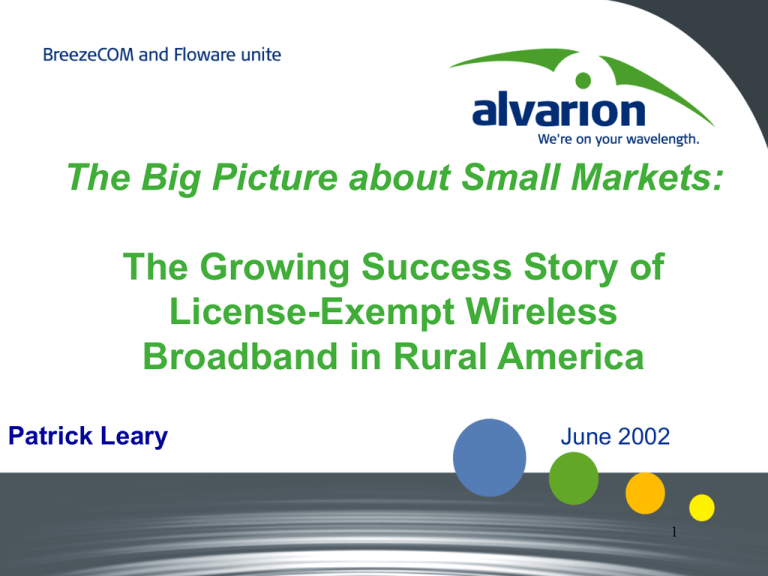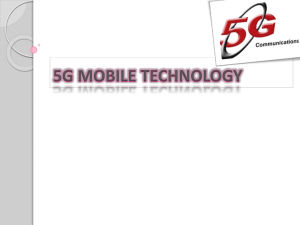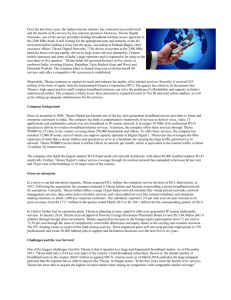Patrick Leary - Odessa Office Equipment
advertisement

The Big Picture about Small Markets: The Growing Success Story of License-Exempt Wireless Broadband in Rural America Patrick Leary June 2002 1 One quick note. Why are we qualified to speak to you today? • The merged companies of BreezeCOM and Floware • Approx. 60% of the global market share (Strategies • • • • • • 2 Unlimited 2002) Largest R&D in the Industry Major contributor to base IEEE 802.11 (mid ’90s). Active in IEEE 802.11b. Co-Chair IEEE 802.11a standard committee, active in IEEE 802.16 Largest installed base in the world (over 500,000 units) Significant deployments in more countries (about 100) Major global OEM partners include Alcatel, Siemens, NEC Serve all major public and private bands (2.4GHz, MMDS, 3.5GHz, UNII, 5GHz ISM, 10.5GHz, 26GHz as well as many other bands specific to individual markets such as ETSI) 2 Defining Key Terms High Speed Wireless (as it primarily relates to the technology explosion in the US) : IP-based wireless delivery of information in replacement or compliment of wire line technologies at multi-megabit Horizontal distribution of 802.11b capable speeds. WLAN for Internet access in small, strategic pockets. Wireless LAN “Hotspots” Wireless connection of specific nodes, local or remote, to form a shared, common LAN. Usually 802.11b. Wireless Broadband 3 Wireless delivery of high-speed Internet/IP services over a geographic range to enable access for an unrelated set of users. Most consist of either 802.11b-based systems or proprietary 3 protocols in 2.4GHz, and now proprietary 5GHz. The upcoming 802.16a is expected to full additional growth. Technology Adoption Cycle – Unlicensed Wireless Broadband in North America The market is trending toward the ISO’s V Slop towards acceptance Sales peak V Late comers Now = v o l u m e Market saturation Conservative adopters (telcos, utilities) 2002/2003 Early adopters (small, private ISPs) 2000/2001 4 Incubators ( ISPs like Midcoast, Odessa Office) 1998/1999 4 In the NTCA’s fall 2001 annual broadband report, where they survey members regarding their broadband statistics and plans, fully 100% of respondents said broadband was at least “somewhat important” to their future (86% said very important). Not a single respondent said it was of little importance. 5 The same set of respondents said their cable and xDSL offerings would be flat in 2002, but that their wireless deployments 5 would double. U.S. Unlicensed Wireless Broadband U.S. Wireless Broadband Markets Markets West 417 Southw est 306 Midw est 1115 Southeast 237 Northeast 340 0 200 400 600 Markets Served (Total = 2415) 6 800 1000 1200 6 Unlicensed Fixed Wireless Broadband Markets by State State Markets State Northeast Markets State Southeast Markets State Midw est Markets State Southw est Markets West Connecticut 11 Alabama 12 Illinois 220 Arizona 53 Alaska Delaw are 2 Arkansas 15 Indiana 245 Colorado 77 California Maine 16 Florida 69 Iow a 124 New Mexico 16 Haw aii 9 Maryland 15 Georgia 13 Kansas 42 Oklahoma 14 Idaho 41 Massachusetts 33 Louisiana 14 Kentucky 13 Texas 146 Montana 24 New Hampshire 25 Mississippi 5 Michigan 81 Nevada 5 New York 33 North Carolina 43 Minnesota 177 Oregon 13 Ohio 64 South Carolina 17 Missouri 42 Utah 69 Pennsyvania 125 Tennessee 23 Nebraska 82 Washington 50 Rhode Island 11 Virginia 24 North Dakota 4 Wyoming 13 Vermont 5 West Virginia 2 South Dakota 35 Wisconsin 50 Northeast 340 Southeast 237 Midwest 1115 Southwest 306 5 188 West 7 7 417 Unlicensed Wireless Broadband Estimates* • Approx. 400,000 US unlicensed fixed wireless • • • • 8 subscribers, but we expect about 2M by 2005. Currently we estimate 80% subscribers are commercial generating about $300M in annual subscriber revenue. Residential estimate of about $70M annually, but expected to increase 10x by 2005. Estimates do not include “hotspot” revenues (over 6,000 US hotspots expected by end of 2002) US WLAN sales expected to be about $2B by 2004 (InfoTech). Market expected to experience 5x growth in 5 years * Data is compiled by Alvarion, based on combinations of available market reports 8 Contrast that to licensed broadband providers including MMDS-based or LMDS-based wireless broadband • Even at its peak and before they ceased adding customers, Sprint, by its own count, had only 35,000 subscribers to its national wireless broadband service • WorldCom’s national subscriber counts were estimated to be under 40,000 • 2001 also saw the failures of Winstar, Teligent, and ARTS 9 All these spectrum assets are being held, but few customers in any markets are being 9 served. Fixed Wireless Broadband Global Subscriber Growth* (in thousands, incl. All bands unlicensed + licensed) 2000 2001 2002 2003 2004 2005 2006 396 572 897 1,395 3,497 6,319 10,019 Alvarion estimates 20% of these relate to US numbers 10 * Source Allied Business Intelligence, Inc. published Q4, 2001 10 …an example of service availability in just two states… South Dakota Baltic, Big Stone City, Brandon, Buffalo, Buffalo Ridge, Canton, Casper, Castlewood, Cody, Colton, Crooks, Dell Rapids, Ellis, Garretson, Gillette, Harrisburg, Hartford, Hudson, Humbolt, Hurley, Kranzburg, Lennox, Montrose, Parker, Pipestone, Rawlins, Renner, Rowena, Sioux Falls, Sioux Valley, Tea, Valley Springs, Watertown, Worthing 11 11 …and Minnesota 12 Albert Lea, Albertville, Alpha, Anoka, Argyle, Arlington, Atwater, Avoka, Baxter, Beaver Creek, Bell Plaine, Bergen, Bernadotte, Beauford, Biegelow, Big Woods, Bingham Lake, Bird Island, Biscay, Blakely, Bloomkest, Brainard, Brewster, Brooklyn Park, Browton, Buffalo Lake, Burlington, Burnsville, Butterfield, Cavalier, Cedar Mills, Champlin, Chandler, Clarks Grove, Cleveland, Cloquet, Cokato, Comfrey, Corchester, Corvuso, Cosmo, Courtland, Currie, Danube, Darwin, Dassel, Dodge Center, Duluth, Donaldson, Dundee, Eagle Lake, Elk River, Ellsworth, Elysian, Fairfax, Fairmont, Faribault, Fulda, Gaylord, Gibbon, Glencoe, Grafton, Grand Rapids, Hallock, Hancock, Hadley, Hamburg, Hanska, Haugen Farm, Hayfield, Henderson, Hector, Heron Lake, Hills, Howard Lake, Humbolt, Hutchison, Iona, Jackson, Jeffers, Jessenland, Kandiyohi, Kasota, Kennedy, Kinbrae, Kittson, Klossner, Kurth Farm, Lafayette, Lake Bronson, Lake Cystal, Lake Jennie, Lake Lillian, Lake Shetek, Lake Washington, Lake Wilson, Lakefield, Lumberton, LaSalle, LeSueur, Lismore, Little Falls, Lonsdale, Luverne, Madison Lake, Mankato, Maple Grove, Minneapolis, Montevideo, Morgan, Morris, Mt. Lake, Nash, New Auburn, New London, New Ulm, Nicollet, Norseland, Northcote, North Field, North Mankato, Olivia, Ortonville, Osseo, Otsego, Owatonna, Piertz, Plato, Prior Lake, Ramsey Reading, Remmers Farm, Rogers Rosemont, Round Lake, Rushmore, Sartell, Sauk Rapids, Savage, Shultz Farm, Searles, Shakopee, Skyline, Sleepy Eye, Sioux Valley, Slayton, Spafford, Spicer, Springfield, St. Cloud, St. George, St. James, St. Michael, St. Paul, St. Peter, St. Thomas, Steen, Stephen, Stewart, Stordon, Sumter, Tabor Angus, Thompson, 12 Thorpe, Traverse, Truman, Vernon Center, Waite Park, Warren Waterville, Webster Farm, Wilder, Wilmar, Wilmont, Windom, Winthrop, Worthington Who is deploying unlicensed wireless broadband for complete local coverage? Private ISPs Local Telcos Public Utilities and Electric Co-ops Small Cable Operators Rural Cellular/PCS Carriers City/County Governments Public Safety groups (e.g. Police/Fire) 13 13 So what is really driving this phenomenon in rural America? It is a quality of life issue!! To attract and retain businesses to ensure a strong commercial tax base and the availability of good jobs. To create “access equity” for schools and libraries so their children have the same access as do children in a metro area. To build a virtual community that enhances the physical community by improving municipal services and encouraging participation. 14 These groups are increasingly choosing wireless due to the inequitable access to, and lack of control 14 with, wireline options, as well as short ROI. ROI Example for Premium Grade Brand • Assumptions: • • • • 350 subscribers: 250 residential/ SOHO, 100 SME Monthly charges: $50 res./ $200 bus. Installation charges: $100 res./ $300 bus. 2 populated Base stations installed for about $25K each (capacity is about double this sample) • Assumes 2 T3’s for Internet pipe at monthly cost of $7,000 • Assumes high average CPE cost of about $700 • Results: • • • • • Wireless hardware investment of $295,000 Customer installation charges $55,000 Monthly revenue of $32,500 Monthly income (less Internet pipe cost) of $25,500 Hardware ROI in just under 9.5 months 15 15 16 16 17 17 Summary Unlicensed wireless broadband, with only the support of the free market, is growing well even in a severely contracted market. Contrast that to the dismal failure of national MMDS license holders in the space. 18 Clearly, the FCC’s greatest broadband success story is the one least appreciate, least understood, and least supported. With only a modicum of support, this market will become the catalyst for national broadband equity and the key to economic growth and vitality of the 18 rural community. THANK YOU 19 19




